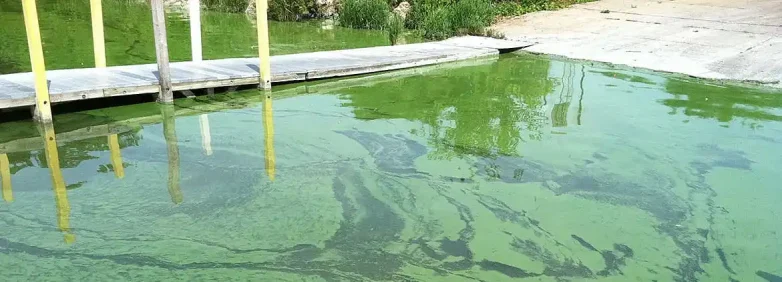NC POLICY WATCH

Hotter summers spurred by climate change are likely making more and more bodies of water in NC unsafe
There have been more than 300 public reports of algal blooms in North Carolina this year, 100 in June alone, according to the NC Department of Environmental Quality.
And climate change could be at least partly responsible.
Algal blooms occur when algae overproduce. Some algae, mainly blue-green, can produce toxins that harm wildlife, pets and people who come into contact with them by swimming in or ingesting the affected water.
People should avoid any body of water that looks unsafe according to NC DHHS recommendations.
Algae blooms can deter tourism and recreation, kill fish and reduce property values near affected lakes. These blooms can also make it more expensive for water treatment plants to process drinking water, the cost of which is passed on to ratepayers.
Blooms can occur for various reasons, such as major changes in water chemistry and dramatic swings in dissolved oxygen. They can appear as surface scums and discolor the water.
Badin Lake in Stanly County and Jordan Lake, which spans parts of Durham, Wake and Chatham counties, have been especially hard-hit. Both lakes are drinking water sources for hundreds of thousands of people.
“The majority of bloom reports submitted to the dashboard in June were related to the algal issues in Badin Lake,” said Anna Gurney, spokeswoman for the Division of Water Resources at the DEQ.
DEQ investigated the algal blooms in both instances at Badin Lake and Jordan Lake throughout June and July. At Badin Lake, the blooms had toxic black matt algae, while Jordan Lake showed a low amount of toxic algae.
Several storms have occurred at Jordan Lake from the DEQ’s initial sampling that has flushed the algae bloom out of the area.
Although it’s common for algae blooms to appear in the summer in North Carolina, Gurney said the increase in reports shows that people are becoming more aware of the blooms and reporting them more frequently.
Though the dashboard is relatively new and faster for people to report an algal bloom, they can still call or email the DEQ.
Though algal blooms can occur at any time of the year, she said they are more frequent in the summer. “Often, rain washes nutrients and other pollutants from the land into waterways,” Gurney said. “This can lead to blooms soon after when the sun comes out and temperatures begin to increase.”
Furthermore, when the algal blooms start to die, bacteria decompose their cells, leading to low oxygen levels. Low oxygen can kill fish.
Gurney said that the best way to decrease algal blooms is by reducing the nutrients, such as fertilizers, in a waterbody. In addition to fertilizer runoff, other nutrient sources include animal waste and leaking septic systems can flow into a waterbody and create an algal bloom.

Hans Paerl, a distinguished professor at UNC-Chapel Hill’s Institute of Marine Sciences, said these blooms are becoming more significant, mostly due to blue-green algae, which produces toxins.
“The blooms are increasing, particularly in freshwater systems,” Paerl said.
He also said climate change is playing a big role in the increase.
According to data by the State Climate Office, June was the warmest since 1895 and the driest in more than 30 years. In addition, the lack of flushing in lakes due to the low inflows can create stagnant conditions, promoting blooms.
“Climate change complicates things even more,” he said. “We can’t manage climate change very easily in the short run, but we can reduce nutrient inputs which is probably the best way to reduce these blooms or try to control them.”



